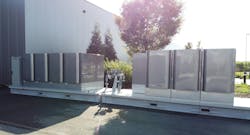Oracle’s Global AI Infrastructure Strategy Takes Shape with Bloom Energy and Digital Realty
Bloom Energy’s Mid-Year 2025 Data Center Power Report points to a seismic shift in data center energy strategy: by 2030, 27% of facilities expect to be fully powered by on-site generation. That’s a sharp increase from just 1% in 2024, underscoring growing concerns with grid power, including limited availability, reliability issues, and a lack of operator control over their energy sources.
Aman Joshi, Chief Commercial Officer at Bloom Energy, is direct about what’s driving demand for the company’s on-site power solutions:
Decisions around where data centers get built have shifted dramatically over the last six months, with access to power now playing the most significant role in location scouting. The grid can't keep pace with AI demands, so the industry is taking control with onsite power generation. When you control your power, you control your timeline, and immediate access to energy is what separates viable projects from stalled ones.
On-Site Power Moves from Option to Imperative
What was once considered a blue-sky idea, i.e. building on-site power generation alongside data center development, has rapidly become the most practical and often necessary solution in many markets.
Grid connection delays in major data center regions, especially those experiencing rapid growth like Northern Virginia, Dallas, and Atlanta, now run one to two years longer than developers previously anticipated, delaying both project delivery and capital deployment.
Where fiber access and connectivity once ranked just behind land availability in site planning, power availability has now emerged as a critical constraint. Bloom Energy reports that 84% of industry leaders rank power as a top-three concern in their planning decisions.
Unsurprisingly, AI is the primary force behind this spike in demand. Power requirements for hyperscale campuses are projected to more than double, with average loads expected to exceed 350 MW by the early 2030s. Many newly announced campuses are aiming for multi-gigawatt footprints from the start.
In this environment, on-site generation, exemplified by Bloom’s solid oxide fuel cell (SOFC) Energy Servers, offers a compelling alternative: rapid deployment, timeline control, modular scalability, high uptime (from three to five nines), and often a lower carbon footprint than grid-supplied power. In many cases, the ability to bring reliable power online within months is the decisive factor.
According to Bloom’s latest Mid-Year Power Report, 38% of data center facilities are expected to use some form of on-site generation by 2030, up from 13% last year.
Bloom Energy: A Leading Force in On-Site Power
As of mid‑2025, Bloom Energy has deployed over 400 MW of capacity at data centers worldwide, working with partners including Equinix, American Electric Power (AEP), and Quanta Computing. In total, Bloom has delivered more than 1.5 GW of power across 1,200+ global installations, a tripling of its customer base in recent years.
Several key partnerships have driven this rapid adoption. A decade-long collaboration with Equinix, for instance, began with a 1 MW pilot in 2015 and has since expanded to more than 100 MW deployed across 19 IBX data centers in six U.S. states, providing supplemental power at scale. Even public utilities are leaning in: in late 2024, AEP signed a deal to procure up to 1 GW of Bloom’s solid oxide fuel cell (SOFC) systems for fast-track deployments aimed at large data centers and commercial users facing grid connection delays.
More recently, on July 24, 2025, Bloom and Oracle Cloud Infrastructure (OCI) announced a strategic partnership to deploy SOFC systems at select U.S. Oracle data centers. The deployments are designed to support OCI’s gigawatt-scale AI infrastructure, delivering clean, uninterrupted electricity for high-density compute workloads. Bloom has committed to providing sufficient on-site power to fully support an entire data center within 90 days of contract signing.
With scalable, modular, and low-emissions energy solutions, Bloom Energy has emerged as a key enabler of next-generation data center growth. Through its strategic partnerships with Oracle, Equinix, and AEP, and backed by a rapidly expanding global footprint, Bloom is well-positioned to meet the escalating demand for multi-gigawatt on-site generation as the AI era accelerates.
Oracle and Digital Realty: Accelerating the AI Stack
Oracle, which continues to trail hyperscale cloud providers like Google, AWS, and Microsoft in overall market share, is clearly betting big on AI to drive its next phase of infrastructure growth. To that end, the company recently announced a strategic expansion of its collaboration with Digital Realty, aimed at helping enterprise customers accelerate deployment of hybrid IT and AI solutions through Oracle Cloud Solution Centers hosted on Digital Realty's PlatformDIGITAL®.
These jointly operated centers -- located in Singapore, Frankfurt, and Northern Virginia, with virtual access via London -- offer secure environments where customers can design, test, and validate real-world cloud and AI architectures. Digital Realty, an Oracle FastConnect partner, brings global colocation, multicloud, and interconnection capabilities directly to these engagements, enabling faster deployment and tighter integration of AI workloads into enterprise environments.
“We are simplifying the journey to cloud and AI adoption,” said Patrick Cyril, Global Vice President, Sales and Customer Excellence at Oracle. “Oracle Solution Centers' integration with Digital Realty's colocation and connectivity solutions enables customers to architect and deploy cloud and AI workloads confidently, with a clear and seamless blueprint for success.”
Added Tony Bishop, Senior Vice President of Enterprise and Platform Solutions, Digital Realty, on the benefits of working with OCI:
Our collaboration with Oracle underscores our shared commitment to helping customers navigate the complexity of hybrid IT and AI adoption. By leveraging our Pervasive Data Center Architecture (PDx) and Oracle's technologies, we're bringing cloud and AI capabilities directly to the data, where customers need them. This will help our customers to achieve faster innovation, together with Oracle, reducing deployment friction and accelerating outcomes.
To wit, the collaboration includes a library of 15 verified infrastructure use cases, deployment-ready architectures, and a set of integrated PDx blueprints to support interconnection and data mobility between cloud, edge, and enterprise environments. Digital Realty’s ServiceFabric orchestration platform and solution architecture teams further streamline implementation and interconnection across OCI services such as Dedicated Region, Exadata, and FastConnect.
Real-world results are already emerging: publishing group Grupo Anaya, for example, used Oracle FastConnect via PlatformDIGITAL to cut latency and network costs by 75% while improving end-user performance by up to 40%—achieving these gains a full year ahead of schedule.
Partnership Benefits for Oracle, Digital Realty, and Bloom Energy
Oracle’s strategic partnerships with both Digital Realty and Bloom Energy signal a deliberate integration of scalable compute, connectivity, and clean onsite power, in an approach designed to meet the aggressive timelines and energy demands of AI infrastructure deployment.
As established above, through its collaboration with Digital Realty, Oracle can rapidly extend the reach of its Oracle Cloud Infrastructure (OCI) platform via PlatformDIGITAL, unlocking faster customer onboarding, access to validated AI use cases, and a library of hybrid IT deployment blueprints. Meanwhile, Bloom Energy enhances Oracle’s infrastructure stack with its solid oxide fuel cell systems, capable of delivering dedicated, uninterruptible power to entire data centers within 90 days of contract signing.
Viewed together, these partnerships give Oracle a differentiated edge: Digital Realty accelerates the deployment of cloud and AI services globally, while Bloom Energy removes dependence on strained grid expansion timelines, allowing Oracle to scale at will, with greater control over energy availability, sustainability, and resilience.
Meanwhile for Bloom, the opportunity to power OCI deployments at Digital Realty campuses could open up a new set of global customer sites and significantly boost its installed base. And as Oracle adds new AI capabilities to OCI, the combination of PlatformDIGITAL’s deployment velocity and Bloom’s fast-turnaround power provisioning forms a tightly aligned infrastructure strategy, built not just for speed, but for independence, sustainability, and scale.
Mahesh Thiagarajan, Executive Vice President, Oracle Cloud Infrastructure, explained the importance of Bloom Energy to OCI customers:
We continue to see strong global demand for OCI services across our entire data center portfolio including our large gigawatt AI data centers. Customers expect to run their AI workloads and new AI applications at peak performance. Bloom's fuel cell technology will join OCI’s extensive energy portfolio, further supporting our cutting-edge AI infrastructure with reliable, clean power that can be quickly deployed and easily scaled.
In this episode of The Hydrogen Podcast, host Paul Rodden connects the dots between digital infrastructure, clean energy innovation, and the real-world deployment of hydrogen inside Oracle and Bloom Energy's bold data center play.
Onsite Power’s Role in Oracle’s AI Growth Trajectory
Bloom Energy’s aforementioned Mid-Year 2025 Data Center Power Report provides deeper validation for the strategy behind its collaboration with Oracle. Based on a survey of 100 data center infrastructure stakeholders - including hyperscalers, utilities, and GPU cloud providers - the report confirms that access to power has overtaken connectivity as the top priority in data center site selection, cited as a top-three concern by 84% of respondents.
The data further quantifies the urgency: developers are underestimating grid interconnection timelines by up to two years, creating a significant risk of delay in AI infrastructure deployment. Bloom’s promise to deliver full-site power within 90 days, as part of its agreement with OCI, directly addresses this gap.
The new OCI–Bloom agreement should therefore be viewed as more than a tactical deal. It really represents a forward-looking infrastructure model. Oracle’s decision to integrate fuel cell-based onsite power into its AI data center roadmap suggests a paradigm shift: an infrastructure design where clean, high-reliability power is delivered in parallel with, rather than waiting on, utility-scale grid readiness.
Aman Joshi, CCO of Bloom Energy, underscored the implications: “Oracle Cloud Infrastructure requires power solutions engineered to meet the performance and reliability demands of today’s most advanced AI and compute workloads.”
In addition to deployment speed, Bloom’s SOFC systems are highlighted for their lack of water use and virtually zero air pollutants, features that quietly align with Oracle’s broader clean energy goals. Even as carbon reduction remains a secondary priority to capacity and deployment timelines, the report found that 95% of data center leaders still maintain formal sustainability targets.
Ensuring a Foundation for AI at Scale
In essence, the partnership between Oracle and Bloom is about more than just keeping pace with AI; it’s really about building a future-proof foundation for AI scale. With average hyperscale campus sizes projected to more than double to 375 MW or more in the next decade, OCI’s ability to deploy both compute and power on fast, modular timelines may become a defining competitive advantage.
Ultimately, the collaboration positions Oracle to gain control over a historically vulnerable nexus of data center development. With Digital Realty as a global colocation partner, and Bloom Energy as a rapid deployment energy partner, Oracle is constructing a uniquely integrated infrastructure stack: one that may prove critical as grid constraints, land competition, and AI demand converge.
About the Author

David Chernicoff
Matt Vincent
A B2B technology journalist and editor with more than two decades of experience, Matt Vincent is Editor in Chief of Data Center Frontier.



